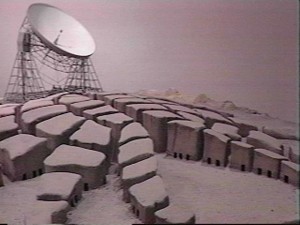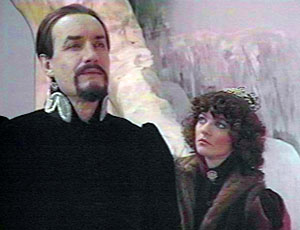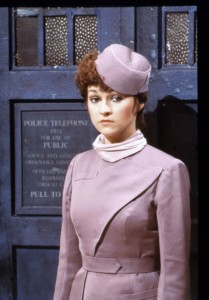 “The Master’s already at work on Logopolis— I’m going to stop him if it’s the last thing I do.”
“The Master’s already at work on Logopolis— I’m going to stop him if it’s the last thing I do.”
[Warning: spoilers below]
Disturbed by events on Traken, especially the way the Master disguised his TARDIS, the Doctor decides it’s time to make some repairs to his own ship, starting with the chameleon circuit. Doing so will require detailed measurements of a real police box, followed by a trip to Logopolis, a planet (or city or monastery, it’s not clear) where scholars have dedicated themselves to the study of “block transfer computations,” the most advances of all possible mathematics and the type of calculations the chameleon circuit uses to create the TARDIS’ exterior appearance.
The Master has anticipated the Doctor’s plan and manages to get own TARDIS inside the Doctor’s, causing problems that occupy the first half of the story before the action finally shifts to Logopolis itself— where the Master’s sabotage will accidentally unleash a threat to the existence of the universe itself. The Doctor will have to join forces with his arch-enemy to stop the disaster the Master has unleashed.
While all of this is going on, our heroes find themselves haunted by a mysterious spectral figure they end up calling “the Watcher.” When the Doctor goes to confront the Watcher, we don’t get to hear what they say: but the Doctor returns from the meeting very disturbed, saying “I’ve just had a glimpse of the future.” The Watcher, it will finally be revealed, is a reflection of the Doctor’s future self at the moment of his regeneration, and the end of the Fourth Doctor is at hand.
Tom Baker played the Doctor for seven seasons, the longest of any actor in the role to date (and, even though seasons by his tenure were shorter than those of the sixties, he also appeared in more stories and more individual half-hour episodes than any other Doctor). During his tenure, the Classic series achieved the highest ratings it ever would. At the time there was no home video, and the BBC did not show repeats, so for the series’ youngest fans he was the only Doctor they’d ever seen. So his departure was probably the most significant turnover in Dr Who’s lead actor since the first one, when William Hartnell gave way to Patrick Troughton.
The producers decided to send him off in grand fashion, with the full return (only just started at the end of Keeper of Traken) of his arch-enemy the Master, and a climax with the entire existence of the Universe at stake. The last minute alliance of the Master and the Doctor, in response to the Master unleashing a threat greater than he expected, was a frequent plot twist back when the the Third Doctor fought the Master back in the UNIT era. But things have changed: although it’s the Doctor who proposes they cooperate out of necessity, the Master is delighted by the idea and seems to regard it as a victory over his rival, while the Doctor seems almost nauseated by it. The change reflects the fact that this new Master is a considerably more malignant figure than his previous incarnation (see below).
The story has an overall gloomy feel right from the start, foreshadowing not only the looming fate of the Fourth Doctor but also the truly catastrophic events of the climax. The story opens in the TARDIS cloisters— a room combining the familiar “roundels” of the TARDIS walls with crumbling stone pillars wrapped in climbing vines, where the Doctor is pacing back and forth as he worries about the Master’s actions on Traken. The setting emphasizes the theme of ancientness, age and decay that has run through every story of season 18. The ominous sound of the cloister bell (heard here for the first time) adds a feeling of doom. After the Doctor speaks to the Watcher and learns at least some of what’s coming, the mood becomes downright funereal.
Despite that, the story avoids being merely depressing. It moves along at a steadily-building pace, starting slow and quiet but picking up momentum as it passes through a series of different set pieces or phases (the most interesting of which is when the Doctor and Adric are caught in a dimensional anomaly caused by the Master’s TARDIS, producing what might be an infinite regress of console rooms inside of console rooms).
The story doesn’t let us dismiss the Master’s victims as mere extras (like faceless blobs in the background). He enters the story by killing an innocent bystander for no particular reason— but she’s a bystander we’ve just spent a series of scenes watching and getting to know as a developed character. At the climax, we see a graphic of the “entropy field” consuming the universe, but to make sure that’s no mere abstraction, among the worlds consumed is Nyssa’s home planet of Traken, which the viewers know well from the previous story. We don’t need Nyssa’s tearful face to make us feel the shock as we realize that the whole story of The Keeper of Traken, and everything the Doctor achieved in saving their world, has been rendered futile by the planet’s complete destruction just a few days later. So far as I can recall, it’s the only time in the history of Dr Who when something like that has happened.
Logopolis was written by season 18 script editor Christopher Bidmead, who finally gets the chance to do the kind of hard-SF story he’s wanted since he came aboard. Despite talk about how transcendentally advanced Logopolitan mathematics are, he keeps the specifics firmly grounded in computer science— that is, the computer science of 1981. There’s no point saying that the result sounds dated now, Bidmead was rightly thinking of the TV audience of that time rather than of 2014. But even in 1981 it seemed out of place for the TARDIS to be so grounded in (then) present-day technology. The TARDIS works best when it lives inside Clark’s law (indistinguishable from magic) and Dr Who as a whole works best when it keeps near the soft side of the SF spectrum. I just can’t quite get past seeing the TARDIS programmed using hexadecimal machine code typed into a Radio Shack TRS-80 keyboard, or the leader of Logopolis trying to debug his code, or the Doctor being impressed by “bubble memory” which retains its data even when the power is shut off. Back in the sixties, the Doctor might open a panel on an advanced alien spacecraft and find it using vacuum tubes, and yet it seems less dated, because they didn’t stop to explain how vacuum tubes are the pinnacle of technology. Dr Who just needs to stay away from “hard” SF, it’s not its proper territory.
But that’s a minor complaint, Overall, in my opinion Logopolis is one of the two best stories of season 18, coming in just behind the winner, State of Decay.
The Regeneration
The Fourth Doctor’s regeneration is a really beautiful scene. The climax of the story takes place high atop a radio telescope on present-day Earth. After stopping the Master’s final scheme, the Doctor falls and is left hanging on to a cable. He has a flashback to a selection of villains he faced during his time, then his grip gives way and he falls while his companions watch in horror.
The camera does a beautiful crane move in to the Doctor lying motionless on the ground (studio shooting in this era just couldn’t do crane moves, the cameras were too heavy, the crew must have put some serious effort into getting this shot). The music at this point is really beautiful. His companions run to his side. “Doctor! Doctor!” This leads into a flashback of every previous companion of the Fourth Doctor calling “Doctor.”
He gives them his trademark toothy smile. “It’s the end,” he says, “but the moment has been prepared for.” He reaches out a hand and the Watcher appears, approaches, seems to merge with him. He briefly turns into the white, spectral appearance of the Watcher, and then a new face appears, sitting up to look at his companions with a bemused expression, as the credits roll.
The Master
 Anthony Ainley will play the Master through the rest of the Classic series. The new version of the character will prove to be a villain of far simpler motivations and character than the original incarnation played by Roger Delgado. (Fans who like to “play the game” and find ways to tie the Classic series’ inconsistencies all together speculate that his long time spent as an emaciated near-skeleton may have driven him mad.)
Anthony Ainley will play the Master through the rest of the Classic series. The new version of the character will prove to be a villain of far simpler motivations and character than the original incarnation played by Roger Delgado. (Fans who like to “play the game” and find ways to tie the Classic series’ inconsistencies all together speculate that his long time spent as an emaciated near-skeleton may have driven him mad.)
Delgado’s Master often seemed to be playing a game with the Doctor, and though he was unquestionably evil (he racked up a very large number of murder counts against him in just about any episode where he appeared) there was an undercurrent to suggest he wasn’t quite beyond redemption, and that he still had some memory of the childhood friendship with the Doctor that’s been mentioned now and again. Barry Letts and Terrance Dicks had originally planned to write out the character of the Master by having him possibly (it was to remain ambiguous) sacrifice his life to save the Doctor’s. It’s impossible to imagine the new version of the Master doing something like that, or even having viewers believe he might. The new Master is pretty much one-dimensional, a madman if not an outright psychopath.
One sign of this less thoughtful characterization comes right in the design of the character. The original Master was very carefully crafted to be an evil opposite of the Doctor: unfailingly courteous where the Doctor was often childish and rude, wearing subdued black clothes where the Doctor was flamboyant, and of course evil where the Doctor was good. In the same way, the version played by John Simms in the new series was crafted to be a shadow version of David Tennant’s Tenth Doctor. But Anthony Ainley’s Master is neither an opposite of the Fourth Doctor or the incoming Fifth. He wears black and has an evil goatee because he’s Snidely Whiplash, not to make a contrast with the Doctor, and his mannerisms are equally those of a simple mustache-twirling villain.
Sometimes this works better than it might sound. Here in Logopolis the Master works well. He’s effectively the monster of the story rather than a character, leaving the main dramatic attention to fall on other characters He doesn’t need a well-rounded persona for that role. He’ll work out well in some future stories as well— but not in others. More on that when we get to it.
Tegan Jovanka
 Two new companions join the TARDIS crew this week. Nyssa of Traken, introduced last week though she didn’t join the crew then, meets up with our heroes on Logopolis, in search of her father.
Two new companions join the TARDIS crew this week. Nyssa of Traken, introduced last week though she didn’t join the crew then, meets up with our heroes on Logopolis, in search of her father.
And Tegan Jovanka (left), on her way to the first day of her new job as an “air stewardess” (they weren’t saying “flight attendant” yet), gets a flat tire and wanders into the TARDIS thinking it’s an actual police box where she can call for assistance. Played by Janet Fielding, Tegan will become the Fifth Doctor’s most faithful companion, appearing in all but the last two of his stories and joining the short list of companions who stayed for three seasons (Jamie with the second Doctor, Sarah Jane Smith with the Third and Fourth). Tegan is loud, brash and argumentative, and never lets the Doctor get away with any doubletalk. She’s a contrast to the loyalty we generally see in the Doctor’s companions, and that will become a theme for others the Doctor will meet in the future.
It’s notable that both new companions join the Doctor after being essentially orphaned by the Master. Nyssa learns her father was killed by the Master, who has now taken over his body, and then later sees her entire world destroyed as a result of his actions. And the Master enters this story by killing Tegan’s Aunt Vanessa, the only family the Australian-born stewardess has in England. The personal losses of his two new companions become another reason the Doctor’s reluctant to work with the Master at the end of this story, even with the universe falling down around him. Nyssa and Tegan both protest loudly when the Doctor proposes the cooperation.
Details
- Is Dr Who about time travel? Needing to measure a real police box as part of fixing the chameleon circuit, the Doctor notes that there’s a problem: most of them are gone, there’s a only a few “in the north” still in use. Well, why not just land in the 1950’s? The dialog emphasizes a fact about Classic Dr Who: it was not about time travel at all. Earth’s past (or future) was treated dramatically exactly like an alien planet: an exotic location where the Doctor can land and have adventures. Time travel was only nominally involved: it’s how our heroes arrive at the story, it’s never a part of the story itself. There are exceptions, but only a few. This may be the biggest change between the Classic series and the New, which plays with time travel almost constantly in its storytelling.
- TARDISes in TARDISes: The last time this happened was the Third Doctor story The Time Monster. There, the Doctor’s TARDIS and the Master’s materialized “inside each other.” The Police Box appeared in the Master’s console room while the Masters TARDIS (at the time disguised as a computer bank) appeared in the Doctor’s. Entering or leaving either one led only to the other console room, until they were separated. Here, the Master’s TARDIS is unambiguously inside the Doctor’s TARDIS. At first this produces an infinite regress of console rooms (not “looping around” to the actual room, but a series with progressively dimmer lights, like distant reflections in a pair of facing mirrors). This effect vanishes when the Master then moves his TARDIS out of the console room, apparently able to navigate it within the Doctor’s ship at will.
- Why did the Watcher appear? Although we learn who/what the Watcher is, we never learn why he appeared to his earlier self. Christopher Bidmead says the appearance was meant thematically to parallel the phenomena of the infinite console room series (above), no explanation in-universe is ever given: a strange lapse given Bidmead’s attention to scientific detail everywhere else. Feel free to theorize.
Next Week:
“Castrovalva” 4 episodes. New Doctor, new season, new era.

